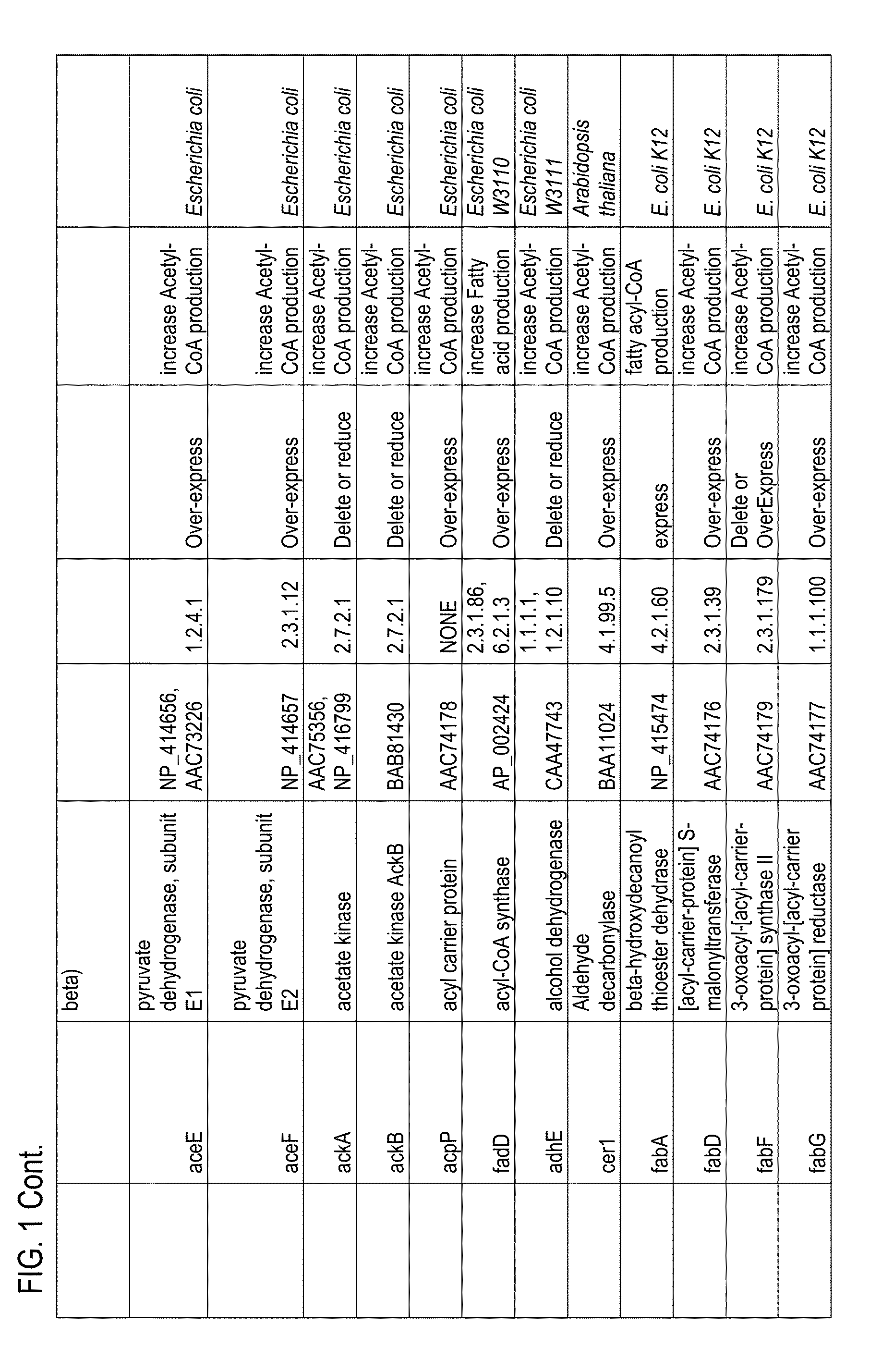Methods and compositions related to thioesterase enzymes
a technology of thioesterase and composition, applied in the field of new compositions of thioesterase, novel recombinant host cells, etc., can solve the problems of increasing the geographical location of industrial-scale biodiesel production, increasing costs and the amount of energy required for fatty ester production, and achieving the effect of improving fuel characteristics
- Summary
- Abstract
- Description
- Claims
- Application Information
AI Technical Summary
Benefits of technology
Problems solved by technology
Method used
Image
Examples
example 1
Production Host Construction
[0528]An exemplary production host is LS9001. LS9001 was produced by modifying C41(DE3) from Overexpress (Saint Beausine, France) to knockout the fadE gene (acyl-CoA dehydrogenase).
[0529]Briefly, the fadE knockout strain of E. coli was prepared using primers YafV_NotI and Ivry_O1 to amplify about 830 by upstream of fadE and primers Lpcaf of and LpcaR_Bam to amplify about 960 by downstream of fadE. Overlap PCR was used to create a construct for in-frame deletion of the complete fadE gene. The fadE deletion construct was cloned into the temperature-sensitive plasmid pKOV3, which contained a sacB gene for counterselection, and a chromosomal deletion of fadE was made according to the method of Link et al., J. Bact. 179:6228-6237, 1997. The resulting strain was not capable of degrading fatty acids and fatty acyl-CoAs. This knockout strain is herein designated as E. coli (DE3, ΔfadE).
[0530]Another fadE deletion strain, MG1655, was construted according to the p...
example 2
Production Host Modifications
[0537]The following plasmids were constructed for the expression of various proteins that are used in the synthesis of fatty acid derivatives. The constructs were prepared using standard molecular biology methods. All the cloned genes were put under the control of IPTG-inducible promoters (e.g., a T7 promoter, a tac promoter, or a lac promoter).
[0538]The ‘tesA gene (thioesterase A gene, GenBank Accession No. NP—415027 without leader sequence (SEQ ID NO:31) (Cho and Cronan, J. Biol. Chem., 270:4216-9, 1995, EC: 3.1.1.5, 3.1.2.-)) of E. coli was cloned into an NdeI / AvrII digested pETDuet-1 vector (pETDuet-1 described herein is available from Novagen, Madison, Wis.). Genes encoding FatB-type plant thioesterases (TEs) from Umbellularia californica, Cuphea hookeriana, and Cinnamonum camphorum (GenBank Accession Nos: UcFatB1=AAA34215, ChFatB2=AAC49269, ChFatB3=AAC72881, CcFatB=AAC49151) were individually cloned into three different vectors: (i) NdeI / AvrII dig...
example 3
Production of Fatty Alcohol in the Recombinant E. coli Strain
[0544]Fatty alcohols were produced by expressing a thioesterase gene and an acyl-CoA reductase gene exogenously in a production host. More specifically, plasmids pCDFDuet-1-fadD-acr1 (acyl-CoA reductase) and pETDuet-1-′TesA (thioesterase) were transformed into E. coli strain LS9001 and corresponding transformants were selected using LB plates supplemented with 100 mg / L spectinomycin and 50 mg / L carbenicillin. Four transformants of LS9001 / pCDFDuet-1-fadD-acr1 were independently inoculated into 3 mL of an M9 medium supplemented with 50 mg / L carbenicillin and 100 mg / L spectinomycin. The samples containing the transformants were cultured at 25° C. in a shaker (shaking at about 250 rpm) until they reached 0.5 OD600. Next, 1.5 mL of each sample was transferred into a 250 mL flask containing 30 mL of the M9 medium described above. The resulting culture was grown at 25° C. in a shaker until it reached an OD600 of between 0.5-1.0....
PUM
| Property | Measurement | Unit |
|---|---|---|
| Tm | aaaaa | aaaaa |
| Tm | aaaaa | aaaaa |
| Tm | aaaaa | aaaaa |
Abstract
Description
Claims
Application Information
 Login to View More
Login to View More - R&D
- Intellectual Property
- Life Sciences
- Materials
- Tech Scout
- Unparalleled Data Quality
- Higher Quality Content
- 60% Fewer Hallucinations
Browse by: Latest US Patents, China's latest patents, Technical Efficacy Thesaurus, Application Domain, Technology Topic, Popular Technical Reports.
© 2025 PatSnap. All rights reserved.Legal|Privacy policy|Modern Slavery Act Transparency Statement|Sitemap|About US| Contact US: help@patsnap.com



